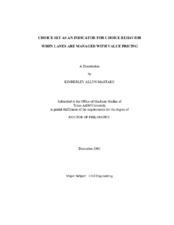| dc.description.abstract | Due to recent pricing studies that have revealed substantial variability in values of time among decision makers with the same socioeconomic characteristics, there is substantial interest in modeling the observed heterogeneity. This study addresses this problem by revealing a previously overlooked connection between choice set and choice behavior.
This study estimates a discrete choice model for mode plus route plus time choice, subdivides the population according to empirically formed choice sets, and finds systematic variations among four choice set groups in user preferences for price managed lanes. Rather than assume the same values of the coefficients for all users, the model is separately estimated for each choice set group, and the null hypothesis of no taste variations among them is rejected, suggesting that choice set is an indicator for choice behavior.
In the State Route 91 study corridor, the price-managed lanes compete with at least two other congestion-avoiding alternatives. The principal hypothesis is that a person’s willingness to pay depends on whether or not he perceives as personally feasible the option to bypass some congestion in a traditional carpool lane or by traveling outside the peak period. The procedure for estimating the choice sets empirically is predicated on the notion that individuals operate within a wide array of unobservable constraints that can establish the infeasibility of either alternative. The universal choice set includes eight combinations of mode and time and route, wherein there are exactly two alternatives for each. Choice sets are formed from an assumed minimum set, which is expanded to one of three others whenever a non-zero choice probability for either ridesharing, or shoulder period travel, or both is revealed in a person’s history of choice behavior.
Based on the test of taste variations, this author finds different values of time across the four choice set groups in the study sample. If these relationships can be validated in other locations, this would make a strong case for modeling choice behavior in value pricing as a function of choice set. | en |


